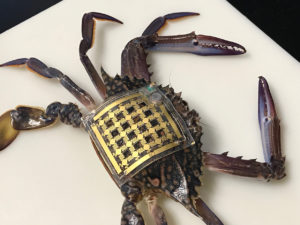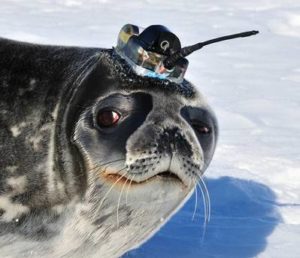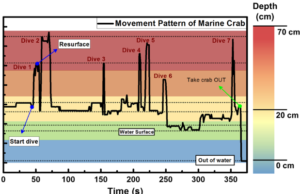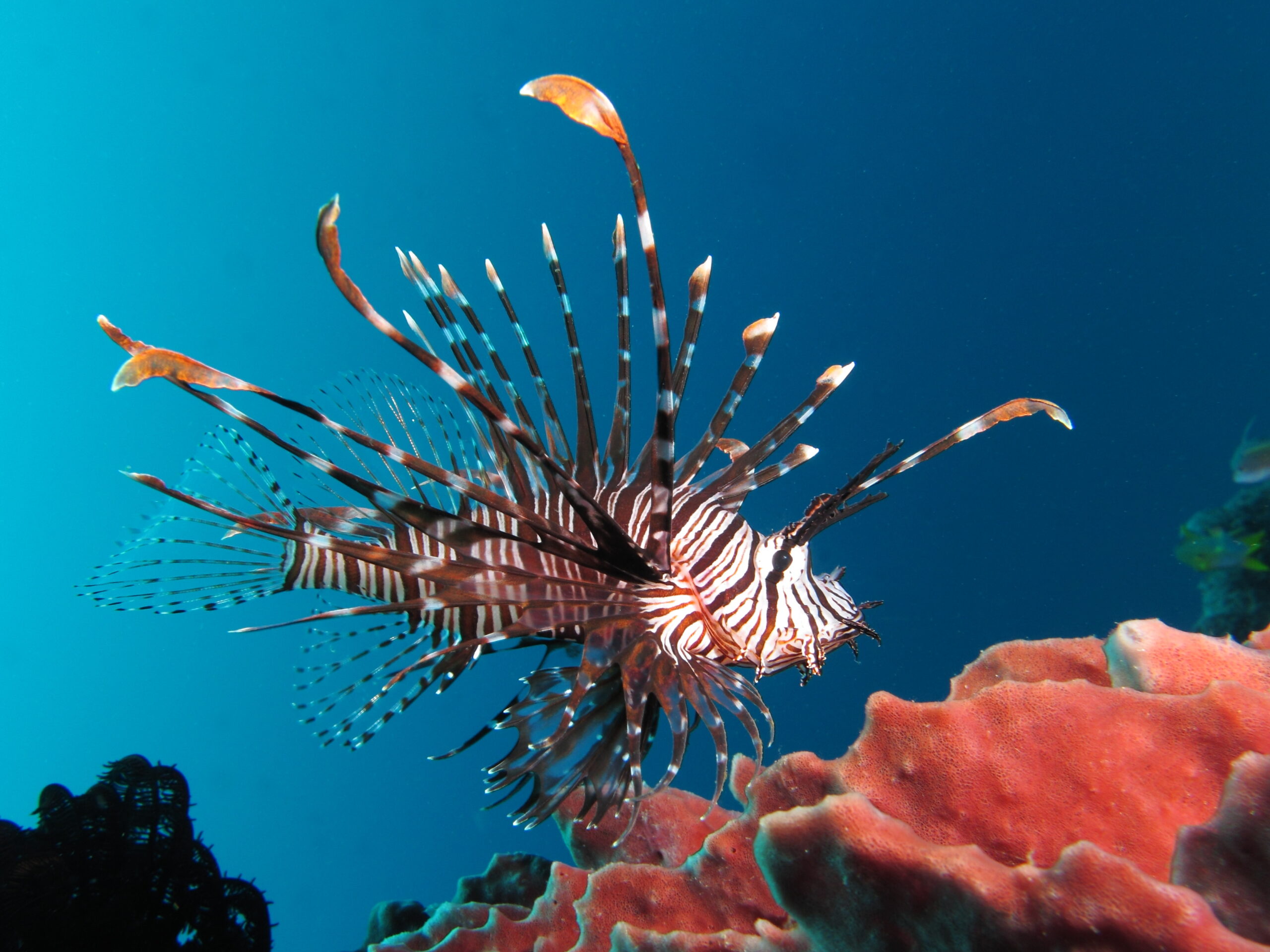This article was originally posted in May 2019. It has been re-posted here following a server issue in which the original post was accidentally removed.
Nassar, J. M. et al. Compliant lightweight non-invasive standalone ‘Marine Skin’ tagging system. NPJ Flex. Electron. 2, 13 (2018). https://doi.org/10.1038/s41528-018-0025-1
Stealthily affixing a tracking device onto a target and subsequently following their every move without their knowledge may seem like cause for ethical concern. In the context of marine animal tagging, however, this practice allows scientist to study the ocean by getting tagged animals to collect data on their underwater environment. One big challenge is improving tagging methods precisely so that animals have no idea that they are being monitored.

A Sea of Change
Marine animals are seeing a lot of transformations to their homes due to the rather callous actions of their human neighbors. We are overfishing, polluting the ocean, and increasing global temperatures – all without much consideration for how this affect marine life. In order to lessen our impacts on the marine world, we need to develop better management strategies. To accomplish this, we must first understand exactly how our activities are impacting marine animals. Unless you happen to be a dolphin whisperer, we can’t really ask them –– so how can we glean this information?
[box]Getting Physical
In the ocean, three key physical variables – salinity, temperature, and pressure – give us a window into the state of the underwater environment and its inhabitants.
Determining the temperature gives an indication of how habitable a particular underwater area is. Variations in ocean temperature influence the species of marine plants and animals that are present in a given location, and alter their migration and breeding patterns. Warmer temperatures can extend the growth season of bacteria, which can contaminate the seafood that humans eat, as well as lead to disease outbreaks in coral reefs. Changes in sea surface temperature can also have profound impacts on global climate. For example, increases in temperature lead to a larger amount of water vapor over the ocean, which feeds storms. By tracking temperature at the sea surface, we can predict the formation of storms, as well as estimate rates of sea level rise.
Salinity refers to the concentration of dissolved salts. The salinity of seawater is controlled by a balance between freshwater inputs (from rivers, rain, and the melting of ice) and freshwater outputs (evaporation and the formation of ice). We can take advantage of this fact by using measurements of salinity to monitor variations in the water cycle, or how water moves from place to place – for example, is sea ice forming or melting? And is evaporation or precipitation occurring over certain areas of the ocean?
Combining salinity and temperature measurements allows us to calculate the density of seawater, which controls ocean circulation. Ocean water is always on the move, and these currents act to transport heat around the ocean – important given that the upper 3 meters (<10 feet) of the ocean alone stores more heat than the entire atmosphere. Changes in salinity and temperature alters ocean current patterns, which in turn have large effects on hurricane formation, droughts, and heat waves. Understanding how water circulates in the ocean is critical in predicting the impacts of climate change.
The third parameter, pressure, allows us to determine depth in the ocean. Different marine species typically occupy distinct depth zones – for example, tuna mostly reside within the upper 200 meters. Tracking the depth of different animals gives us insights into their behavior, such as diving ranges, feeding patterns, and migration between breeding and nursery grounds.[/box]
Tag… You’re It!
In marine biotagging, scientists capture marine animals and outfit them with electronic sensors which can measure salinity, temperature, and/or pressure. After releasing the animals, scientists can then collect data on these parameters as the animals go about their normal activities. This information allows us to indirectly monitor the marine environment, as well as the animals’ behavior.
Clearly, there are a few caveats for this technique to work. Electronic tags should not affect the behavior of the animal they are tracking. This means that discomfort must be minimized, and natural and unrestricted movement be maintained – in other words, tags should be attached noninvasively, and weigh no more than 2% of the animal’s bodyweight (imagine trying to go about your daily activities after having a tag drilled into your skin, or with a 3-pound weight strapped to your body). Given that the whole point is to collect data underwater, sensors should be able to withstand salty water and pressure and temperature variations without an impact on their measurements. Finally, tags must be commercially-viable – the ocean is a vast place, and being able to afford to track only a handful of sea turtles will hardly provide us with great insights.
A variety of marine tags currently exist. However, there remains much room for improvement, including a need for better attachment techniques, improved freedom of movement, and increased tag lifetime.

Fits Like a Second Skin
A new and improved technology – termed “Marine Skin” – was recently developed by Joanna Nassar and colleagues at King Abdullah University of Science and Technology (Saudi Arabia) to address these challenges. The tag is unique in that it is flexible, stretchable, and ultra-lightweight.
Marine Skin consists of thin arrays of temperature, salinity, and pressure sensors made of low cost but robust metals (copper, tungsten, and aluminum) sandwiched between a silicone-based material. It is only 0.3 mm (0.01”) thick, weighs less than 2.4 g, and conforms to the animal it is attached to – handy, since animals rarely take the form of flat blocks. At a logging rate of 2 seconds, its battery can last up to a year. The material and processing cost for each 5.5 cm square patch is a mere $12.
The tag attaches to an animal like a high-quality sticker. During deployment, it continuously collects data, which is stored on an internal memory chip (256 kB capacity). When the animal surfaces for air, the tag transmits its acquired data wirelessly via Bluetooth to a smartphone. For continuously submerged animals, a pop-up device can be used to retrieve data.
Fitbit for Crabs
Nassar and colleagues conducted a test drive of the Marine Skin in the Red Sea, using an unsuspecting crab as their guinea pig. They used superglue to attach the tag onto the crab’s shell, and subsequently monitored its movement patterns over the course of 6 minutes. Data revealed when the crab was diving and resurfacing, and how deep it went on each dive – in essence, tracking the crab’s physical activity.

Skins for All Shapes and Sizes
Although the crab test demonstrated the promise of Marine Skin, further work remains. For one, the crab dove to less than a meter (3 feet) depth. To track other animals, the tag must be able to operate hundreds, or even thousands, of meters under the sea – which will mean coping with immense pressures. Second, using superglue is not ideal for animals with soft skin. As an alternative, the researchers propose using a waterproof adhesive to “tattoo” the tag to mammals. This adhesive was tested on human skin (presumably, no humans were harmed in this test) and lasted for four days. The focus is now on to create Marine Skin patches can operate at greater depths and on other creatures such as dolphins and whale sharks.
Standard tagging techniques involve using shotguns or crossbows to insert tags into the animals’ tissue, or cutting tools and bolts to affix tags to fins. Other tags are so heavy that they hinder the animals’ movement, altering natural swimming and mating patterns. The novelty of the Marine Skin tag is that it is non-invasive and lightweight, while still remaining durable enough for prolonged operation in the harsh underwater environment. Data collected with this wearable sensor will allow us to monitor animal behavior as they navigate a changing ocean, better equipping us to develop conservation policies for marine natural areas. ■
I am a Ph.D. candidate at Boston University where I am developing an underwater instrument to study the coastal ocean. I have a multi-disciplinary background in physics and oceanography (and some engineering), and my academic interests lie in using novel sensors and deployment platforms to study the ocean. Outside of my scholarly life, I enjoy keeping active through boxing and running and cycling around Boston.



We found in 1985 in an experiment that attached “T-Bar” anchor type fish tags to giant clam shells at Rose Atoll, American Samoa, that the superglue used to put the tags together during manufacture was soluble in tropical sea water over long-term exposure. The information part of the tag separated from the anchor portion.